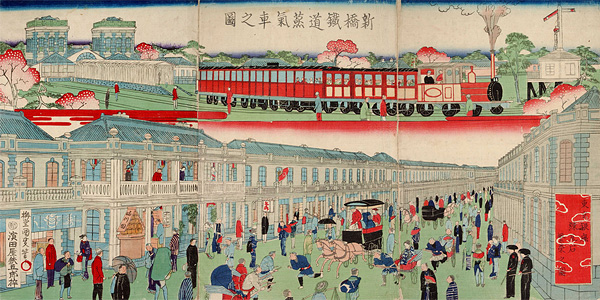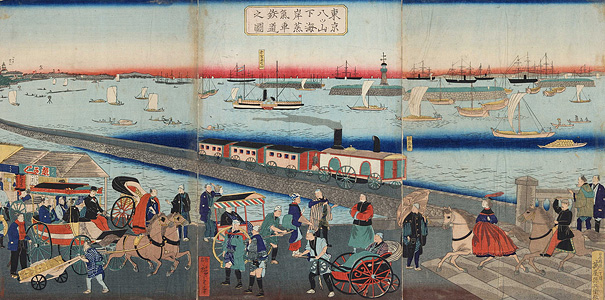A Visit in the Great Edo
A close-up on Edo castle / Cultural enlightenment' spotsSteam Locomotive between Shinbashi and Yokohama
(Tokyo Ginza Rengaseki Hanei no Zu, Shinbashi Tetsudō Jōkisha no Zu)
Painted by Utagawa Kuniteru IV 1873 (Meiji 6)
Commodore Perry of the U.S. Navy came to Japan as his second visit to compel Japan to open its country to the West with the Convention of Kanagawa in 1854 (the first year of Ansei era). He brought a model of a steam locomotive in order to demonstrate American science and technology to the Tokugawa Shogunate. During this time, the Americans were laying down railways across the United States. The railway was one of the symbols of Civilization for the United States.
The locomotive began its service between Shinbashi and Yokohama (present day Sakuragi-chō) in 1872 (the fifth year of Meiji). People at the time called this locomotive "Okajōki". It is likely that this name was given with reference to “jōkisen”, which means steam vessel, as “oka” means on land.
Tokyo (Tokyo Yatsuyamashita Kaigan Jōksha Tetsudō no Zu)
Painted by Utagawa Hiroshige III Around 1871 (Meiji 4)
Shinbashi station was called as it is written here - "Shinbashi station" –(“station “remaining untranslated) during the Meiji period and it became a popular sightseeing spot symbolizing the modernity of the period. The station was designed by an American architect, Richard P. Bridgens, who is also known as the architect who designed Yokohama station and the Yokohama Customs House.
* To view more explanation, please click the each image.




